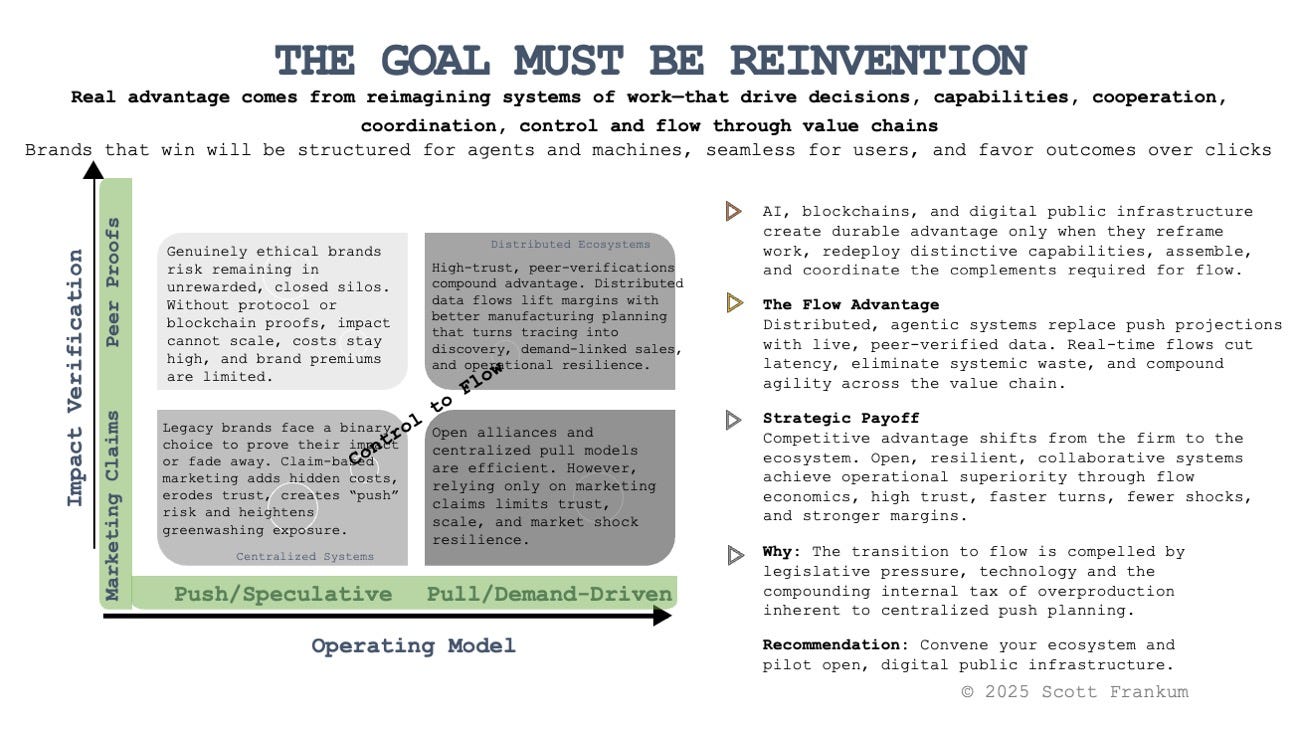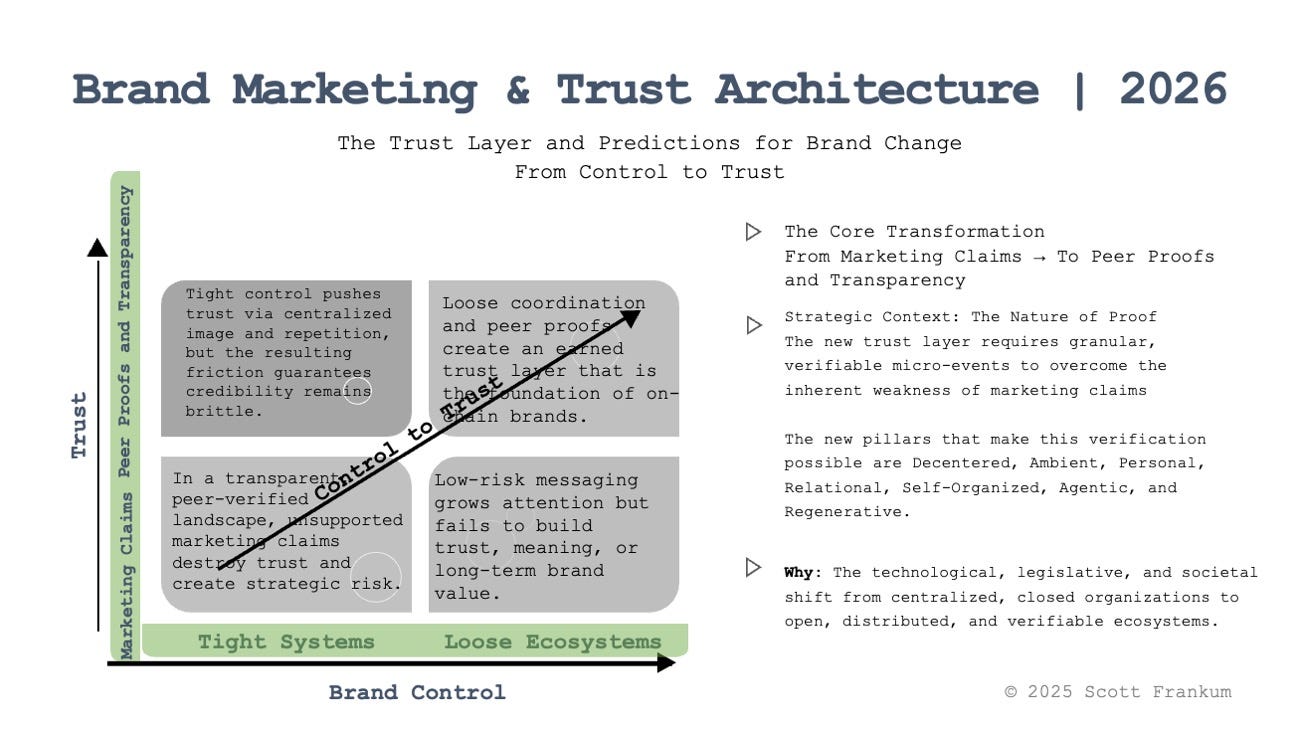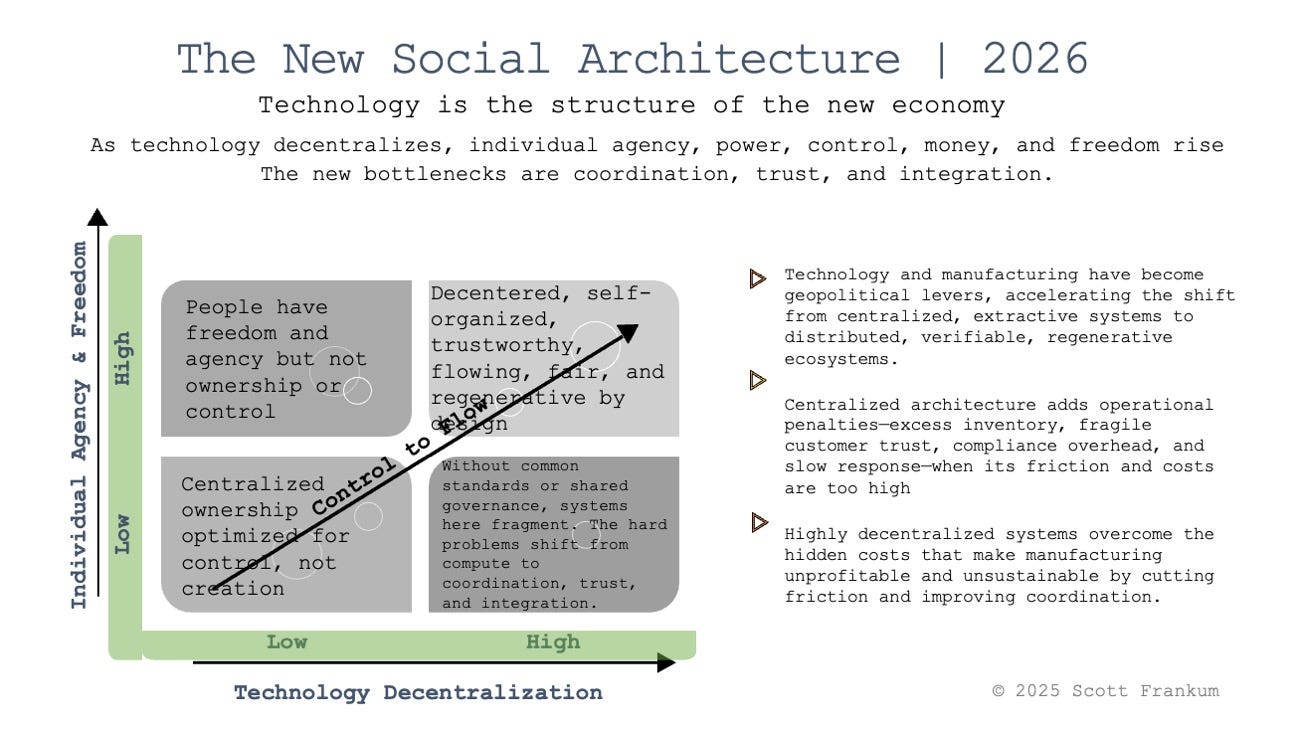Fashion's Climate Compliance Accesses the $5 Trillion Agentic Economy
Digital Public Infrastructure is an All-in-One Solution for Fashion Reinvention
Fashion’s spend on ESG and legal compliance are unrewarded cost centers. The data is static, derived and invisible to the dynamic, machine-readable data systems that now drive online commerce. This is the Information Asymmetry Tax. Marketing needs ESG, but operations rarely benefits. That is changing. This post explores a “Commons Option”— low-risk, open-source infrastructure that turns compliance costs into access to the projected $5 trillion agentic economy.
There is a remarkable, new interrelationship between legislation and technology that rewrites the manufacturing rules of value. In regulated markets, new legislation requires documented product and supply chain data. At the same time, new digital infrastructure makes it cheap to turn those obligations into trustworthy, machine-readable facts.
This post explores an open-source, commons infrastructure for making. In about 50 San Francisco Tech Week conversations, only two people knew what the heck I was talking about. Here’s hoping this helps solve my marketing problem.
Small businesses and non-profits ignore Digital Public Infrastructure, and the new agentic business models it creates—at their own risk. The new symbiosis between legal compliance and technology generates rivers of new data that dissolve competitive moats by transforming the field of competition from speculative marketing claims towards factual product histories. Smart players will recognize that this data will transform manufacturing projections into real-time signals that activate Digital Public Infrastructure and shared, asset-lite, pull, making ecosystems.
The Mechanism
It is wrongheaded to treat fashion supply chain compliance mandates, especially digital traceability, purely as cost, burden, and complexity. The interrelationship of legislation and the technology required to comply drives the creation of trustworthy, signed data graphs (also known as digital product passports), initiates operational savings, and unlocks a (projected) $5 trillion agentic commerce opportunity. Tracing and compliance efforts are strategic levers for capturing a share of this new agentic market. We are moving beyond “technology is a tool” to “technology is the structure of the economy.
The Opportunity
What would manufacturing look like if ethical, Digital Public Infrastructure systems used the data generated by climate legislation to automate low value work—to reason, plan, and act on without human interventions? The Digital Public Infrastructure data is what AI agents use to orchestrate $3 trillion to $5 trillion in global retail revenue by 2030, in normal adoption scenarios. These agents only read JSON-LD structured data, not brand claims.
Manufacturers face three stark choices to solve the Information Asymmetry Tax:
1) Pay the Tax The short-term, high risk / high-cost choice. Continue operating on static, unverified marketing claims. Risk: Remain invisible to AI agents, bleed margin on overproduction, and face regulatory fines.
2) The Comprehensive Overhaul This is a false choice for long-term, high risk / high capital transformation. I call this a false choice because it only applies if you re-choose centralized, extractive, on-chain technologies . If you rip and replace legacy systems with new, centralized ERP blockchains written in JSON and JSON-RPC, you are likely choosing high sunk costs, high failure rates and years of delay.
3) The “Commons” Option This is an iterative, low risk, self-directed, open-source choice to build shared, Digital Public Infrastructure that works for owners, investors, consumers and the planet. This new approach creates a “Commons” for trade where value stays with creators and communities by aligning interests, sovereignty, and verifications across the value chain.
Let’s Restate the Problem
Fashion pays an Information Asymmetry Tax: projected demand, unsupported marketing claims, and expensive, inflexible centralized tech stacks that AI agents cannot trust.
What Open-Source, Digital Public Infrastructure Can Do
Turn ethical integrity costs into revenue by lowering risk for buyers, lenders, and insurers; unlocking premium AI product discovery; creating new financial products (e.g., fractional ownership, carbon derivatives) built on signed product, event, and climate data.
Move inventory, stock-outs, and operating costs in your favor by replacing speculation with granular, real-time demand flows that tracing generates.
Manage regulatory compliance and brand risk with signed product, event, and measurement data needed to meet mandatory EU/California/global compliance standards.
First movers compound gains in planning, margin, resilience, and cost…and lock in AI and agent advantages that late adopters cannot match.
Improve inventory costs, customer trust, regulatory exposure, and response to market signals by shifting from expensive centralized systems to distributed ecosystems.
Link sovereignty, coordination, and verification across the value chain so open ecosystems, shared data signals, and network effects compound into durable advantage.
De-risk the shift from vertical Enterprise Resource Planning (ERP) to horizontal Network Resource Planning (NRP). Remove coordination and integration bottlenecks through low-cost, low-risk experiments and in-person tech sprints/event bootcamps.
Collaborative development at ongoing events reduces strategic and tech debt, field tests UI, UX, and product–market fit faster and at lower cost, engages smallholders and partners, creates network effects, and aligns value chain ecosystems before legislative deadlines trigger catch-up projects.
Position your brand on the right side of geopolitical shifts as technology and manufacturing move from centralized, extractive models to distributed, signed production. Move early to align value and advantage around trusted data and open participation.
Build simple, coordinated systems of work that let agents and machines reason, plan, and act—and lay the groundwork for autonomous manufacturing.
The Shift: A Four-Step Path to Commons Technology and Competitive Advantage
Manufacturing is facing generational change. To manage risk, fashion should reach for clarity and incremental change. Verification is scarce today, but in regulated markets, signed data graphs (like product passports) become abundant as compliance compels trustworthy, machine-readable product data.
Many firms are bolting tracing onto legacy systems, which I predict will cause massive sunk costs in the EU. Specifically, centralized blockchain solutions designed for financial transactions lack the scale, data sovereignty and Global South usability necessary to comply with the granular traceability requirements of EU/California legislation.
More, JSON and JSON-RPC code choices will never meet the letter or spirit of EU/California legislation.
Open-source Digital Public Infrastructure is an all-in-one solution that supports business to build from first principles. Start with what the law demands, the data you need for brand story and the compliance path you’ll take. Move forward step by step toward real-time, signed product, event and climate data.
When trust is ambient, Sustainable Competitive Advantage will be built on four repeatable steps: Establish Structural Sovereignty > Commoditize Proof > Build a Defensible Cost Moat > Capture Emotional Premium
1) Structural Sovereignty > Narrative Sovereignty
Your ecosystem should seek to transform trust and proof into low-cost commodities. Transition your operations on-chain to establish structural sovereignty. This allows the firm to continuously lower the computational cost of proof and build a defensive, competitive moat. Cost efficiency liberates brand resources and shifts the competitive focus to brand story.
2) Go Small to Gain Big
Identify your Atomic Unit of Value, (which is the smallest indivisible measurement unit for a resource, event, or action that retains economic meaning, functional significance, and customer impact). Example: Activate new customer services like product warranty, product authenticity, and regulated lifecycle information on-chain.
3) Find Your People
Ecosystem Autonomy accelerates when you find, influence, and co-create value with your product ecosystem—while negotiating the terms of permissioned interdependence within the network. This shifts Sustainable Competitive Advantage from the individual firm to your network/ecosystem.
4) Brand Curation, Narrative, and Value Innovation
In low-trust environments, brands self-audit truth. Close the trust loop by leveraging ambient trust to focus on market differentiation through storytelling and experiences. Value Innovation is achieved by simultaneously pursuing differentiation and low costs that make competition irrelevant, while Brand Curation uses the new trustworthy data to drive differentiation through storytelling and experiences. Invest resources in storytelling and experiences that capture the Emotional Premium. Achieve operational cost leadership while compounding gains through narrative differentiation.
Make Commons More Common
Manufacturing is facing two invisible disruptions at once. Regulatory waves in the EU and California, demand proof for climate and marketing claims . Meanwhile, AI forces brands to compete on trust, at a moment when neither brands nor AI agents have reliable data.
There is a low-risk, low-cost, all-in-one solution. Granular supply chain tracing in interoperable, JSON-LD code on Digital Public Infrastructure shifts the basis of competition from marketing claims to signed proofs and data graphs. In the new environment, tracing moves from a cost to a solution for climate remediation, compliance, brand sales and new customer services. As technology decentralizes, individual agency, power, control, money and freedom increase.
Set-up a discovery call: Scott@Economy3.org.







